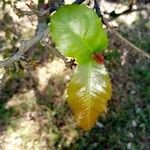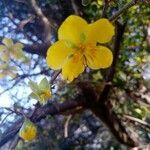Evergreen shrub 1–3 m high; stems with numerous, dense, raised lenticels. Leaves simple; petioles 1–2 mm long; lamina elliptic, 2.5–8 cm long, 7–15 mm wide, acute to obtuse at base and apex, with raised reticulate venation above and below; lateral veins about 30–40 on each side of the midrib; margin finely and sharply serrulate with about 30–40 coarse teeth on each side. Stipules linear, filiform, 1–2 mm long. Flowers perfumed, axillary, usually solitary; pedicels 1–1.5 cm long. Sepals ovate, 8–10 mm long, green at anthesis, to 15 mm long and deep red in fruit. Petals 5, obovate, c.10 mm long, cuneate, bright yellow. Stamens c. 20; anthers dehiscing by pores. Stigma multilobed. Fruits of 3–15 black fruiting carpels embedded in a bright red receptacle. Seeds 5–10 mm long, obloid-ovoid; cotyledons 5–8 mm long; radicle small.
Small, evergreen tree or shrub, 0.6-2.0 m high; wood red; branchlets brown, densely verrucose with lenticels; galls often present. Leaves with lamina elliptic, apex and base ± obtuse, margins sharply serrulate; reticulately veined, thinly coriaceous, shiny, dark green; stipules intrapetiolar, linear, bidentate; petioles 1 mm long. Pedicels dark brown, slender, up to 15 mm in fruit, articulated 1-2 mm above base. Sepals ovate, green, wine red in fruit. Petals broadly obovate. Stamens ± 20; filaments 3 mm long; anthers biporose. Carpels 5, stigmas apical, discoid. Flowering time July-Dec. Fruit oblong-ovoid, black drupelets.
Evergreen shrub or rarely a small tree, 0.6-2.0 m high. Branches densely mottled with lenticels. Leaves with blade narrowly elliptic, 25-50 mm long, margins sharply and closely serrulate. Flowers: solitary or rarely two, on short lateral spurs; pedicels erect or spreading, articulated 1-2 mm above base; carpels 5, oblong-globose, basally attached to receptacle; sepals 5, 10-15 mm long and deep wine-red in fruit; petals yellow, 10 mm long; Aug.-Jan.
Shrub or rarely a small tree, 0.6-2.0 m high. Leaves small, 25-50 mm long. Flowers solitary or rarely bi-nate, pedicels articulated 1-2 mm above base. Sepals 10-15 mm long. Carpels 5. Flowers yellow.
Semideciduous shrub or small tree with warty bark to 2 m. Leaves narrowly elliptic, toothed. Flowers 1 or 2 on short shoots, yellow.



